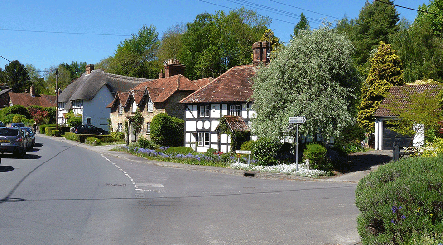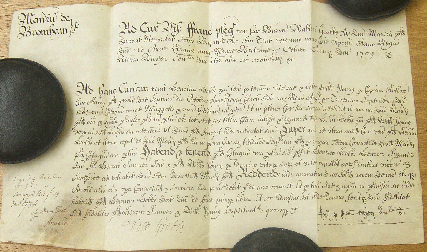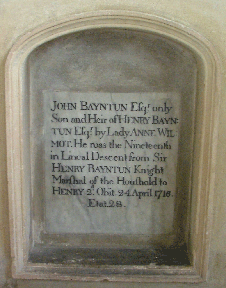
|
Timeline
1688: Revolution in England – James II was was deposed on 23rd December and fled to France in exile after serving as king for just three years. However it was not known technically who should succeed him and there was no replacement for a year. But James was not going to give up without a fight and later moved to Ireland to muster up support. The same year he was defeated at the Siege of Londonderry in Ireland. 1689-1691: Deposed King James II of England, led an Irish Insurrection against British occupying forces. The Irish had French military support and on 11th July, a major battle took place north of Dublin city by the Boyne River. The English, led by William III of Orange defeated the Irish/French army in the Battle of the Boyne. |
John Bayntun was born in 1688, at Spye Park House, in the county of Wiltshire. He was just 3 years old when his father, Henry Bayntun, died on 11th July 1691 at the age of 27 and inherited his estates, including the Manor of Bromham. He held the title Lord of the Manor of Bromham for 25 years of his short life of 28 years. Henry Bayntun's sudden death meant that John and his sister Anne (aged 2) were placed under the guardianship of Mr. Walter Grubbe Esq. of Eastwell House, Potterne, M.P. for Devizes. Following the death of their mother in 1703, Mr. Grubbe, as guardian of these friendless children, took them under his charge and they were brought up at Eastwell, where the accounts for their clothing and education are still preserved. In December 1692, a petition from Henry's widow, Lady Ann Bayntun, and John Bayntun Esq., his four year old son, was read, setting forth that a Bill be presented to the House of Commons, to be passed into an Act, for a speedy execution of a Trust created by the will of Henry Bayntun.
The rents and profits of the said manors at the time were not sufficient to pay the interest of the said mortgage money, by one thousand pounds per annum. The Hungerford lands, when sold, would be sufficient to discharge the debts with a surplus for the said John Bayntun, which otherwise would be swallowed up and the creditors unsatisfied. Between the years 1689 and 1734, deeds for the Enmore estate, or Manor of Enmore, saw many name changes to leases, as the various members of the Bayntun family inherited the property. In 1689 Henry Bayntun is mentioned in a lease involving a cottage held of the Manor of Enmore. In 1705, his son and heir, John Bayntun (then aged 17 years), is named alongside his guardian, Walter Grubbe of Potterne, Wiltshire. By 1714, John is listed as the owner of the Manor in another lease, but two years later he died and his sister, Anne and her husband Edward Rolt of Sacombe Park, Hertfordshire are listed in a reversionary lease dated 1716. It is clear from this deed that Anne inherited the Manor of Enmore after John's death and a further reversionary lease in 1730 lists she and her second husband as The Hon. Lord and Lady Somerville. But by 1734 Anne had also died and her son, Edward Rolt would receive the remainder of the Bayntun estates, including the Manor of Enmore, as was laid down by his uncle John's will. John Bayntun showed no apparent interest in parliamentary service in the family's traditional North Wiltshire borough. Calne had been a safe seat for the Bayntun family throughout the years after six generations of the family served as Members of Parliament. In 1700 John's mother, Lady Anne Bayntun, sold Farleigh Castle to Joseph Honoton of Trowbridge and the Manor of Ilford and the Manor of Rowley to William Chaundler of Bradford and within a few years, Hinton Priory was sold to Walter Robinson. These too were all Hungerford properties which were purchased by Henry Bayntun between 1684-1687. John's mother died suddenly on the 8th August 1703, aged 36 years. She had married, secondly, the Hon. Francis Grevile. John Bayntun married Catherine Broucker, the daughter of Dauntsey Brouncker of Erlestoke, Wiltshire on the 26th February 1711. The Brouncker family were Lords of the Manor of Melksham and lived at Erlestoke. The family name survived in Brounckers Court Farm and Brounckers Hill farm. When Dauntsey Brouncker died in 1693, his estate was divided between his two daughters – Catherine and Anne. The Manor of Erlestoke was passed onto Catherine as part of her share in the estate and eventually became Bayntun property. Her sister was married at the time to James Townsend of Great Cheverell. Between 1713 and 1719 Erlestoke Manor was frequently mortgaged before being eventually sold to Sir George Heathcote, Alderman and M.P. for the City of London in 1720 by John's sister Anne Bayntun-Rolt. In 1694 John Bayntun sold the principal part of the Bremhill estate to Joseph Haskins Stiles, a merchant from Amsterdam. The Bremhill estate was an attractive acquisition, as the land had been neglected and unimproved and it provided significant potential for improvemen. But the Bayntun family retained some property in Bremhill, such as Bremhill Farm, but Haskins was listed as Lord of the Manor in the Bremhill Manor Court Book. Like his father, John Bayntun died young on 24th April 1716 at the age of just 28. His tombstone indicates he was the 19th in lineal descent from Sir Henry Bayntun, Knight of the Household to King Henry II and upon his death, the long line of male Bayntun descendants had died out in the county. John and Catherine had no children of their own and when he died the Bayntun estates were passed onto his only sister Ann Bayntun, with Ann's second eldest son – Edward Rolt – named as his successor and Lord of the Manor of Bromham.
The above memorial to John, replaced an older one that was against the chancel wall, under a canopy. It was of a female figure, inlaid in brass, having a scroll issuing from the mouth, the letters of which were nearly obliterated. The wording was similar to the above and was beneath another inscription, on the same scroll, dedicated to his grandfather, Sir Edward Bayntun, obiit 2 September 1679. The Bayntun family were obviously very proud of their ancestors, in particular Sir Henry (c1189), to have this inscribed on John's memorial. There is however no documented proof that Sir Henry ever held this post. See Sir Henry Bayntun (c1189) After John's death, his next-of-kin was his sister, and heiress Anne Bayntun |





